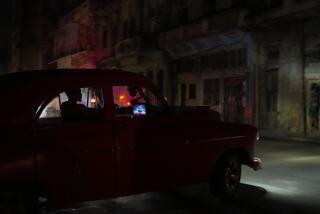‘65 Was Cool but ’77 Was Boiling
- Share via
The first time the lights went out all over New York was Nov. 9, 1965, when the failure of a single relay switch in Ontario, Canada, triggered a sequence of power system overloads that shut down a regional grid, blacking out virtually the entire Northeast within 15 minutes.
It was a night marked by camaraderie as New Yorkers laughed, chatted and generally made the best of a situation.
Twelve years later, on the night of July 13, 1977, New York went dark again. This time, the problem was a local one. Four lightning strikes knocked out vital power lines just north of the city. Automated cutout equipment shut down connections to the regional power grid, confining the blackout to the city.
It was a night marked by shattered glass, fire sirens and screams in the darkness.
But in 1965, despite confusion and disarray, New Yorkers helped each other, according to a study by the Center of History and the New Media.
“Some directed traffic,” the study said. “Others assisted the New York Fire Department as [firefighters] rescued stranded subway passengers. In many cases, New Yorkers shared extra candles and flashlights with neighbors, reveling in the opportunity to get to know the people who lived across the hall.”
Hundreds of thousands were inconvenienced, but for most, memories of that night were fond, according to the study.
“There were garbage cans afire along the street, not because of vandalism, but for light,” a woman who was 20 at the time told the center. “Stores kept doors open and were candlelit.... It was a very exciting adventure.”
In 1977, some neighborhoods, like Greenwich Village, were peaceful. But in others stores were looted. Buildings were set ablaze.
Researchers said that in parts of Harlem, Brooklyn and the South Bronx, thousands took to the streets and smashed store windows, looking for TVs, furniture or clothing. Fifty cars were stolen from a dealership in the Bronx. Police made 3,776 arrests, and 1,037 fires burned throughout the city.
The weather was cool during the 1965 blackout, but in 1977 the city was sweltering under a heat wave exacerbated by the shutdown of air-conditioning systems.
“The heat was intense,” a woman who was then about 16 later told researchers. “When all the lights faded to black, I sat there, afraid to move. I heard screaming. All I could see was the shadows of people, running back and forth in the dark.
“I watched as our neighborhood was destroyed by the people that lived in it. They wrecked and looted our supermarkets, our shopping centers, our clothing stores and department stores. When it was over, our neighborhood was trashed.”
During the 1970s, financial problems had forced government officials to cut services in many low-income parts of the city. Crimes rates had been on the rise.
Like Thursday’s power outage, the 1965 blackout resulted from a domino-effect series of power system failures that began far from the city. Officials said the failure of the relay switch at Sir Adam Beck Station No. 2 disconnected a transmission line, setting off line overloads that weakened the system. To prevent damage to its turbines, generating plants in New York shut down, and, by 5:40 p.m., power to 30 million people had stopped.
By 11 p.m., it began coming back in Brooklyn. By 6:58 the next morning, the lights were back on in all of New York City.
Engineers examined the grid system trying to come up with ways to prevent more blackouts. One solution was an improved system of automated cutout systems to prevent the sequential spread of outages through regional grid systems.
In 1977, the cutout system worked. Automated equipment reacted to the surges by disconnecting the main power supplier, Con Edison, from the rest of the grid. Within minutes, the city went dark, while across the Hudson River, in New Jersey, lights glowed. It took 24 hours to restore service to most of the city.
Why it didn’t work Thursday was not immediately clear.
More to Read
Sign up for Essential California
The most important California stories and recommendations in your inbox every morning.
You may occasionally receive promotional content from the Los Angeles Times.













